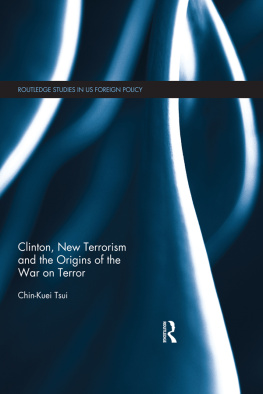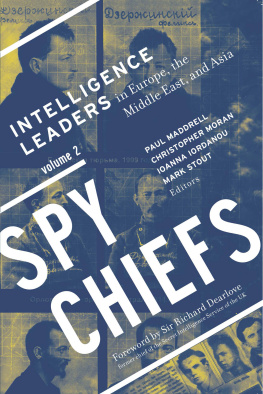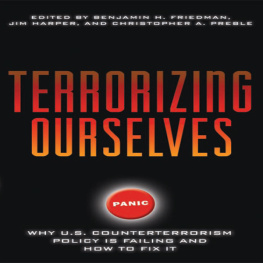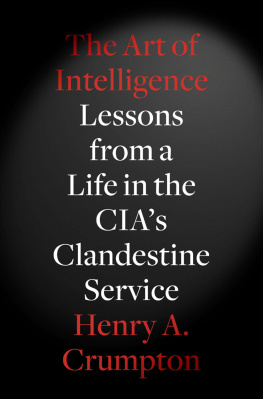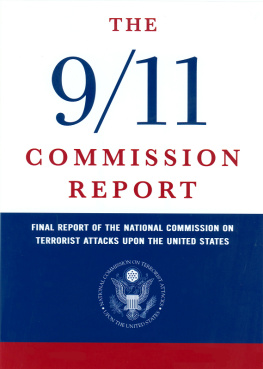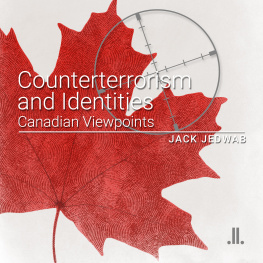ACKNOWLEDGMENTS
During the course of my professional career in the CIAs Directorate of Operations, I had the good fortune of twice working for Fredd Snell, a very fine officer. Fredd was my boss, my mentor, and my friend. He invested an enormous amount of time and energy teaching me the craft. I in turn led and mentored others with Fredds model, and we thus saved many lives. It was an incredible ride. Fredd is a man of high integrity with a passion for America. I would not have accomplished as much in my career had it not been for him. I dedicate this book to Fredd Snell.
I would like to thank Tim Tyler, Professor Neil Rossendorf of Long Island University at C. W. Post, and Professor Seth Jones of the RAND Corporation for their comments and recommendations on early drafts of the book. I would like to thank Capt. Blues Buckholz of the Oregon National Guard for his invaluable assistance. Bluess formal education and background in management and organizational leadership combined with his work on the ground with indigenous forces as a combat engineer in Helmand Province, among other areas in Afghanistan, made him an important contributor. I would like to thank Barbra Nixon, my sister, for her tireless efforts with multiple drafts and for finding a publisher for my policy book.
Finally, I would like to thank my wife, Estela, for her encouragement and support, and my daughter, Alexis, and son, Garrett, for their service to the country. No father is more proud of his children.
ABOUT THE AUTHOR
Gary Berntsen is a retired senior CIA operations officer who has served as a chief of station on three separate occasions. He led the CIAs most important counterterrorist deployments from 1995 through 2005. Since May 2007 he has been serving as an intelligence and counterinsurgency adviser in eastern Afghanistan. Berntsen is the author of the bestseller Jawbreaker: The Attack on Bin Laden and Al Qaeda (Crown, 2005). He has made more than seventy-five television appearances, including numerous appearances on CNN, Fox, MSNBC, and NBC. He lives in Forest Hills, New York.
1. A LITTLE BACKGROUND
In the conduct of foreign policy and in the defense of the United States, the president of the United States and his or her key advisers, including the secretary of state, the secretary of defense, and the national security adviser, draw on multiple sources of information to make policy. A large portion of that information comes from overt sources such as books, newspapers, radio, television, and the Internet. Additionally, U.S. embassies operating in capital cities around the world provide a steady stream of reporting to policymakers in Washington, detailing the state of our relations with foreign governments, whether we maintain diplomatic relations with them or not.
Our embassies, which are also referred to as diplomatic missions, are led by an ambassador who is nominated by the president and confirmed by the U.S. Senate. The ambassador may be a career official of the Department of Statethat is, a foreign service officeror may be from outside the Foreign Service. Those from outside the Foreign Service are known as political appointees. Regardless of their backgrounds, ambassadorial nominees must sit before the Senate for confirmation and receive a majority vote. Ambassadorial nominees appointed when the Senate is out of session are called recess appointments and are required to face confirmation before the end of the Senates next session.
Ambassadors and the foreign service officers under their command are responsible for the United Statess daily interaction with host governments on a range of topics, including the maintenance of economic relations, military agreements, trade, cultural exchanges, and joint involvement in international organizations such as the United Nations. As mentioned previously, among an embassys routine tasks is providing a steady stream of written reports and assessments detailing the state of relations between the United States and the local government.
Foreign governments around the world, whether friend or foe, share their intended policies and intentions with the United States to varying degrees. Most nations that the United States categorizes as allies or friends have a broad and deep relationship with the United States and seek to find ways to further mutual interests. Nations that are either openly or secretly hostile will not share their capabilities and intentions in the course of diplomatic relations. It is the principal responsibility of the Central Intelligence Agency (CIA) and other organizations within the intelligence community to collect information that hostile or competitor nations possess regarding their capabilities and intentions that will advance the ability of the U.S. president and his or her key advisers in making and implementing policy. How information is collected by the CIA and how it conducts other activities, such as covert action, in support of policy underlie the true state of our nations intelligence capabilities. Only with an accurate understanding of what intelligence capabilities we possess can we begin to improve capabilities and fend off the increasing threats that exist in a world of growing danger.
CLANDESTINE INTELLIGENCE COLLECTION
In 2004 the cabinet-level position of director of national intelligence (DNI) was created with the passage of the Intelligence Reform and Terrorism Prevention Act. The DNI replaced the director of central intelligence (DCI) as the head of the sixteen organizations that make up the U.S. intelligence community. The DNI also assumed the role of principal intelligence adviser to the president and National Security Council (NSC). The DCI now focuses solely on his or her principal organization, the CIA, and a new title, the director of the Central Intelligence Agency (DCIA), reflects that change.
The CIA is made up of four basic components, which at times have been shuffled around and renamed but have essentially remained intact during the agencys five plus decades of existence: the Clandestine Service, which fulfills the CIAs primary missioncollection of intelligence through human sourcesand has been known for most of the CIAs existence as the Directorate of Operations; the Directorate of Intelligence, which conducts analysis and writes finished intelligence for policymakers; the Directorate of Science and Technology, which primarily handles major technical collection systems; and finally the Directorate of Administration, which manages the agencys resources and personnel. The Clandestine Services mission, personnel, and leadership are the central focus of this book.
In 2005, to achieve better unity of effort in the field of human intelligence, the CIAs Directorate of Operations and the Department of Defenses Defense Humint Service (DHS) were merged to create a single organization called the National Clandestine Service (NCS). This combined service is directed by the chief of the NCS, who answers to the director of the CIA (DCIA) and the deputy director of the CIA (DDCIA) and is responsible for the broad spectrum of human intelligence operations conducted by the entire U.S. government. A cadre of operations officers (or case officers), collection management officers, and staff officers make up the Clandestine Service.
Operations officers are trained in the art of collecting human intelligence (HUMINT) and are deployed to elements around the globe referred to as stations, bases, and teams, depending on their size, location, and mission. A chief of station (COS) is a senior officer who leads the CIAs efforts in a country. The COS is also the DCIAs personal representative and serves as the principal intelligence adviser to the U.S. ambassador in the country. The COS manages operations officers in the acquisition and handling of human sources, including officials within hostile governments and terrorist organizations, weapons proliferators, and narco-traffickers threatening U.S. interests. These sources provide intelligence to the United States under the risk of identification, arrest, or death, and it is the COSs responsibility not to lose these sources. In those places where the CIA has an existing bilateral relationship with a host governments intelligence service, the COS will manage that relationship with the foreign intelligence service. The CIA station and allied foreign intelligence organizations frequently cooperate in operations against terrorist organizations and hostile governments. These are called


